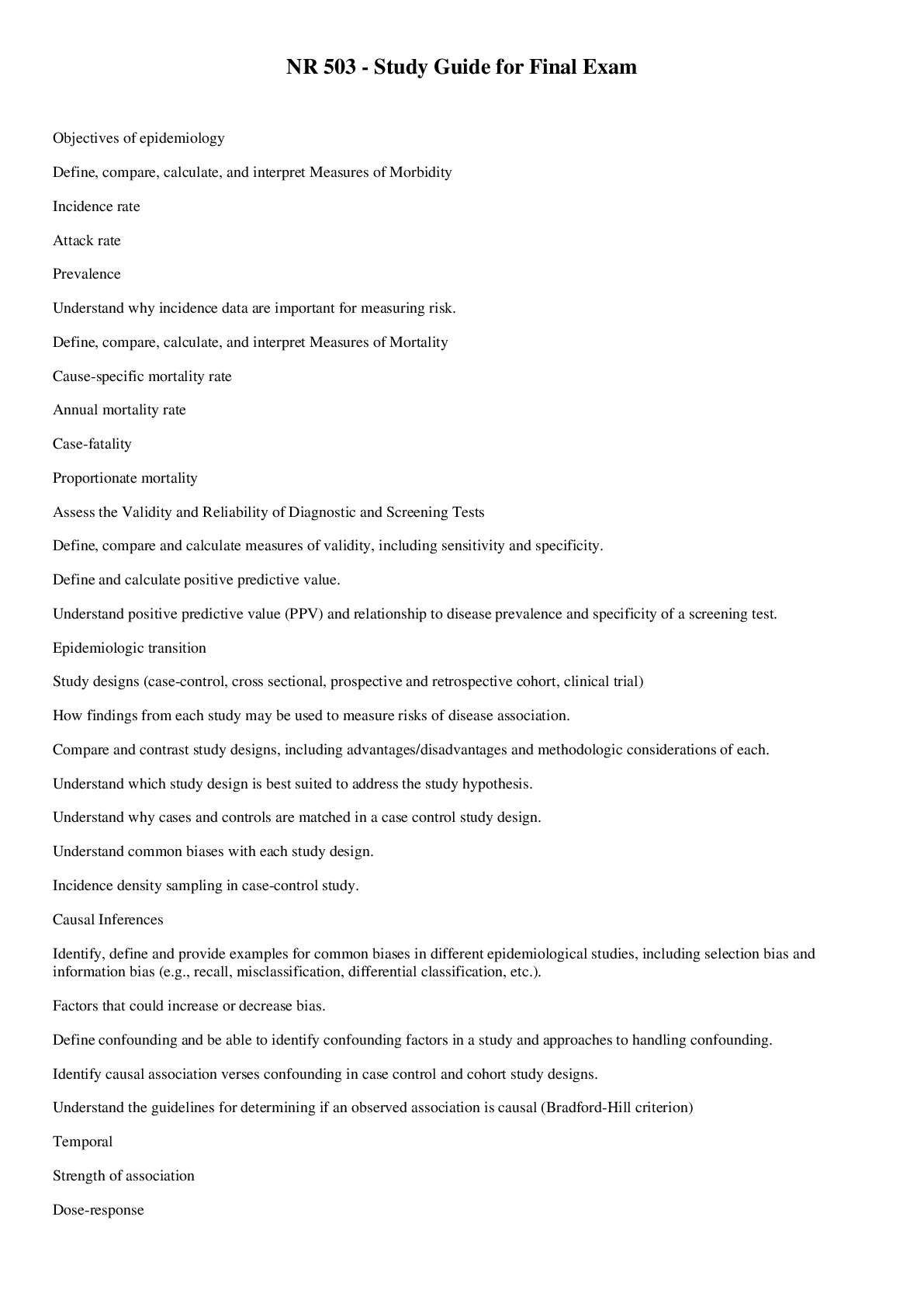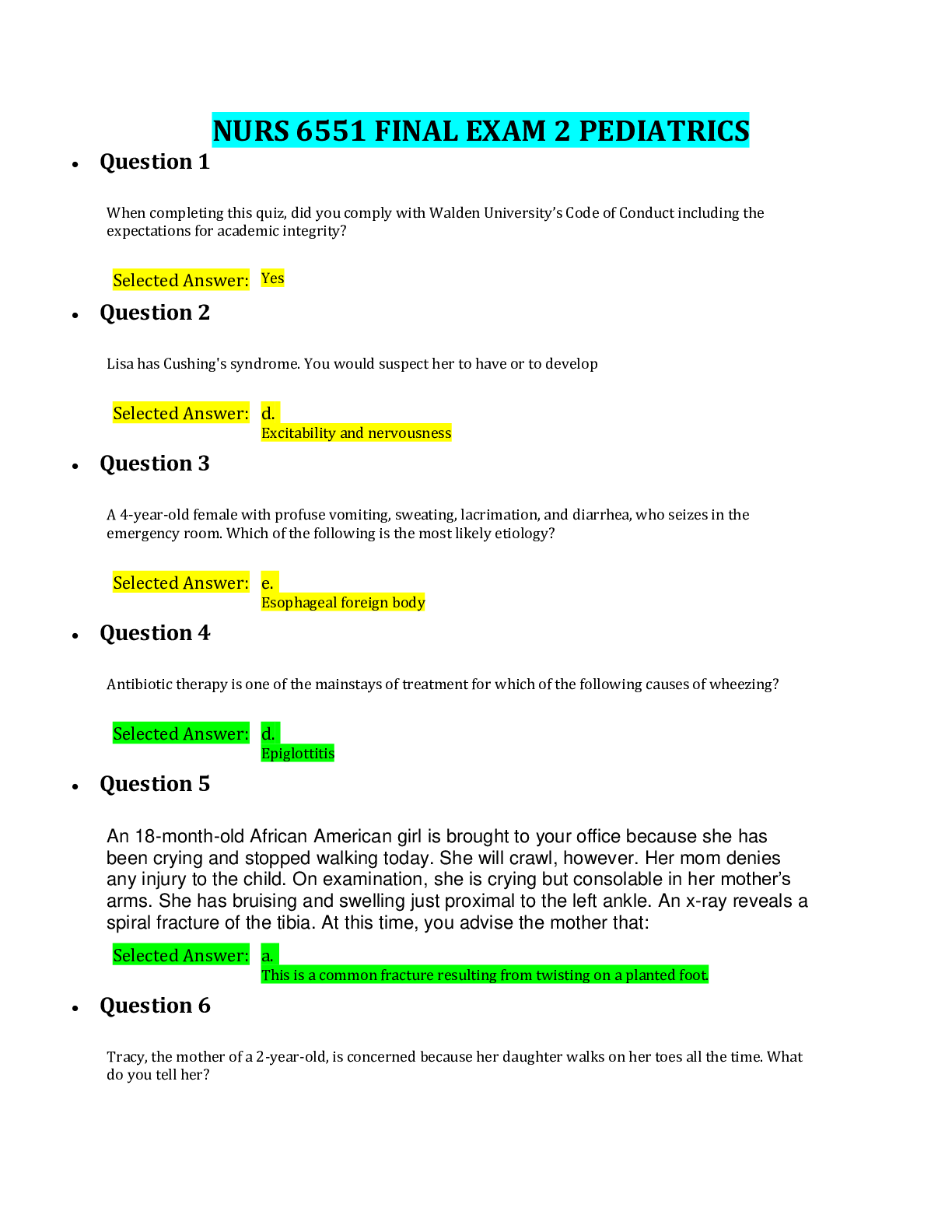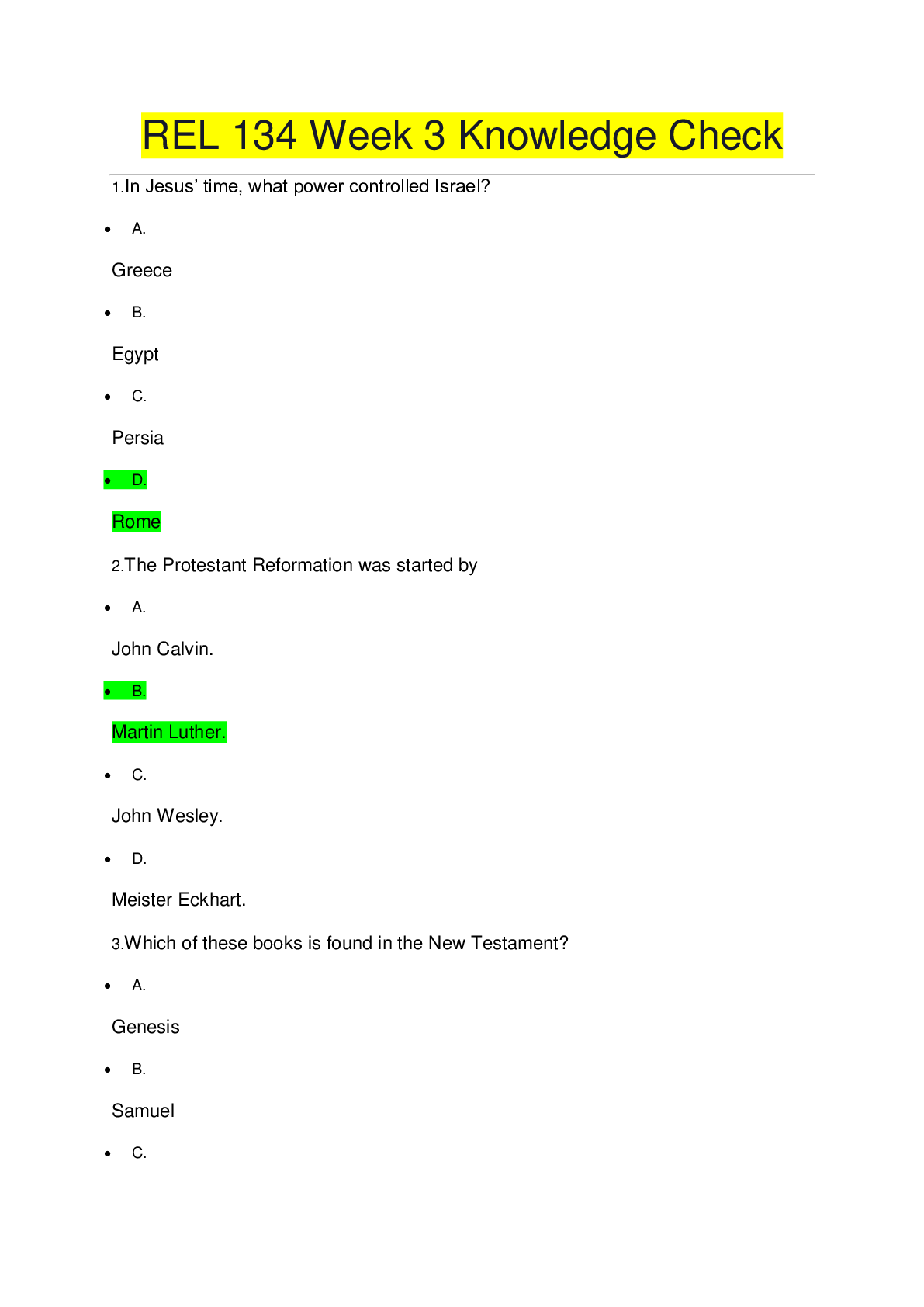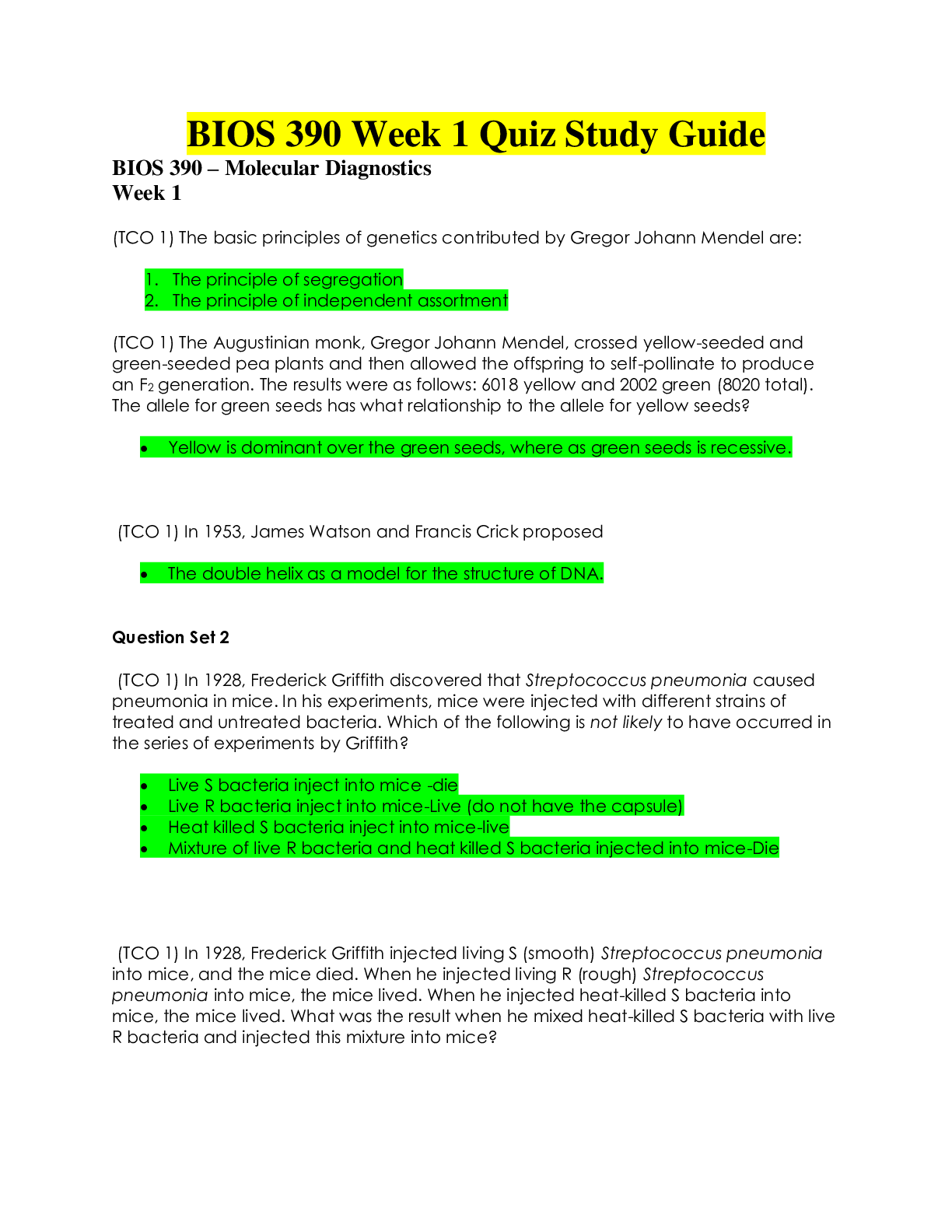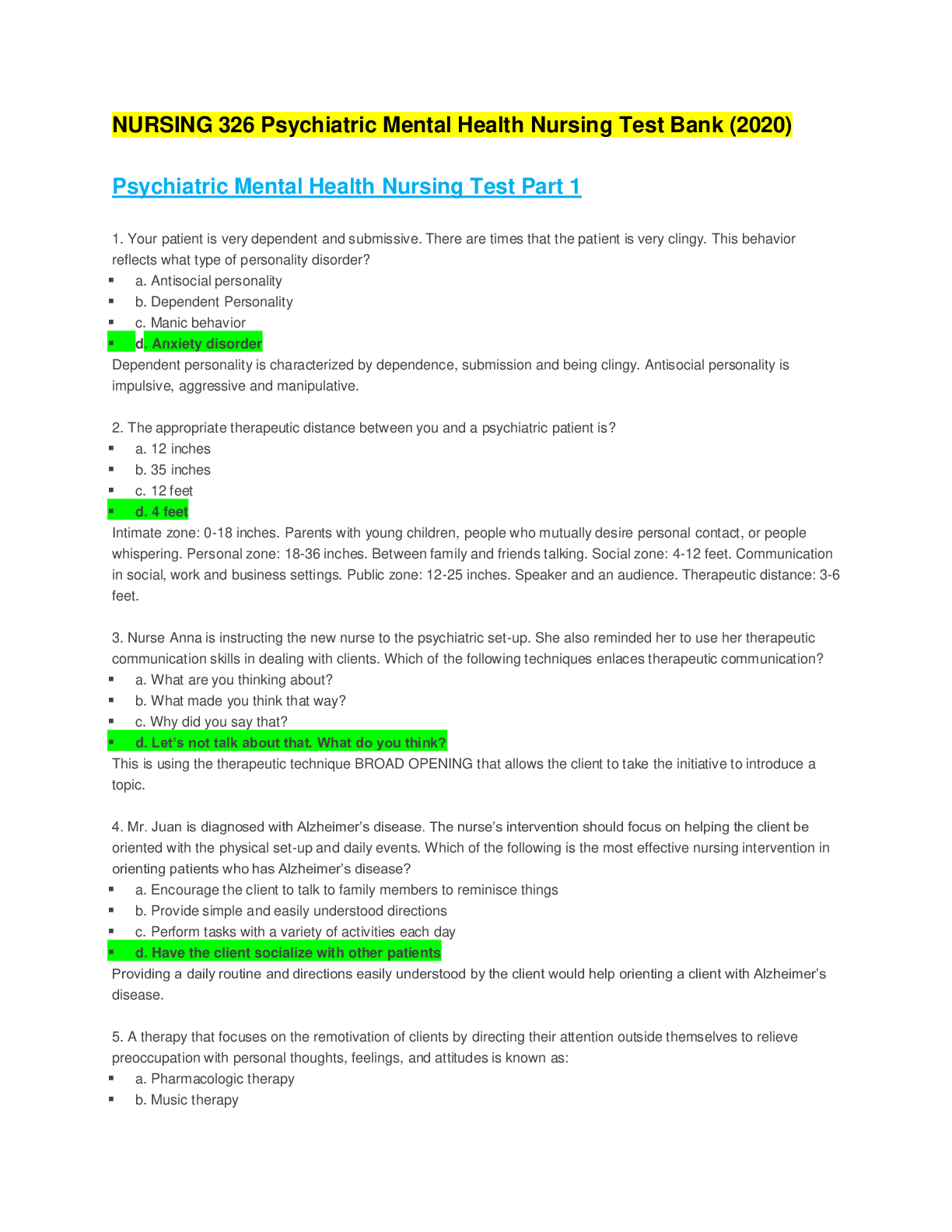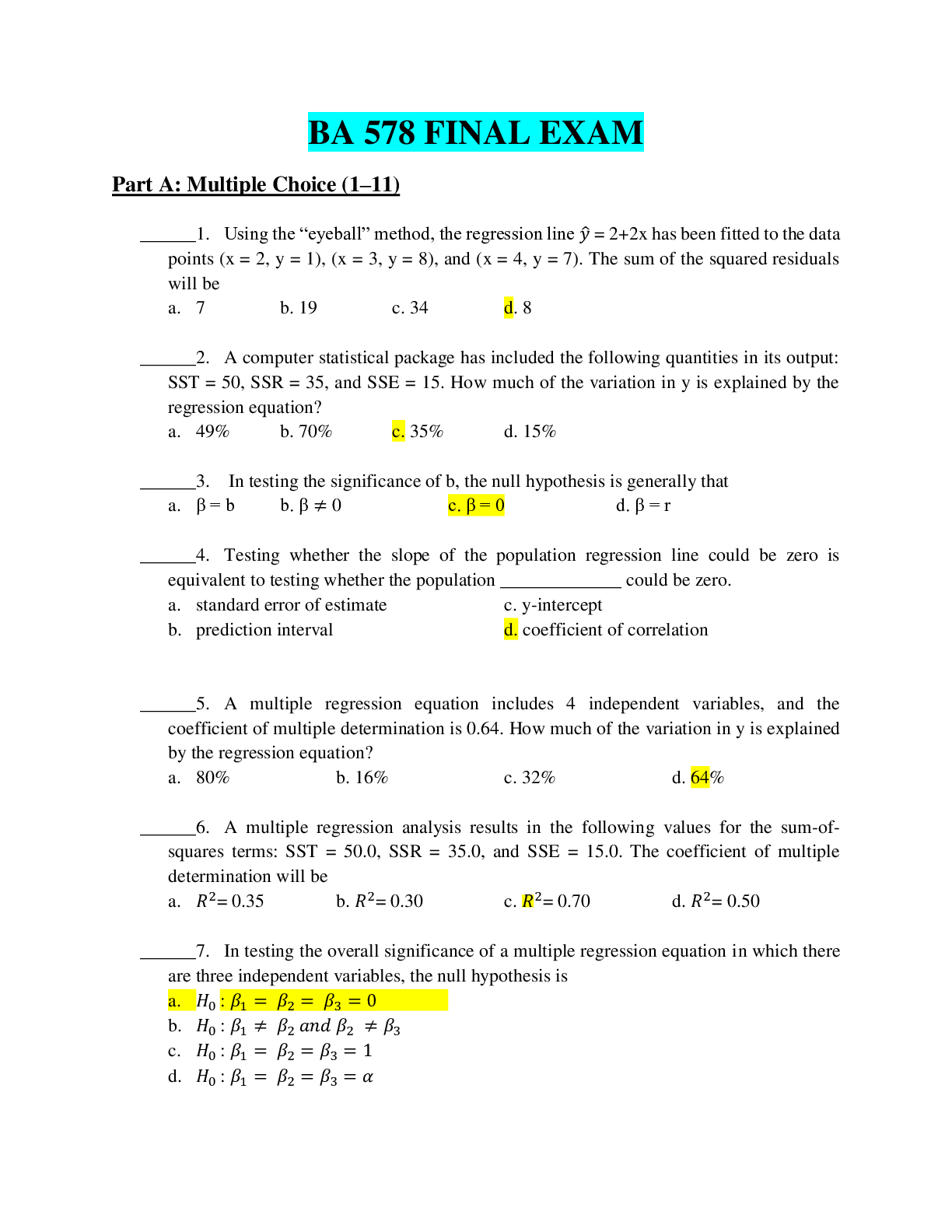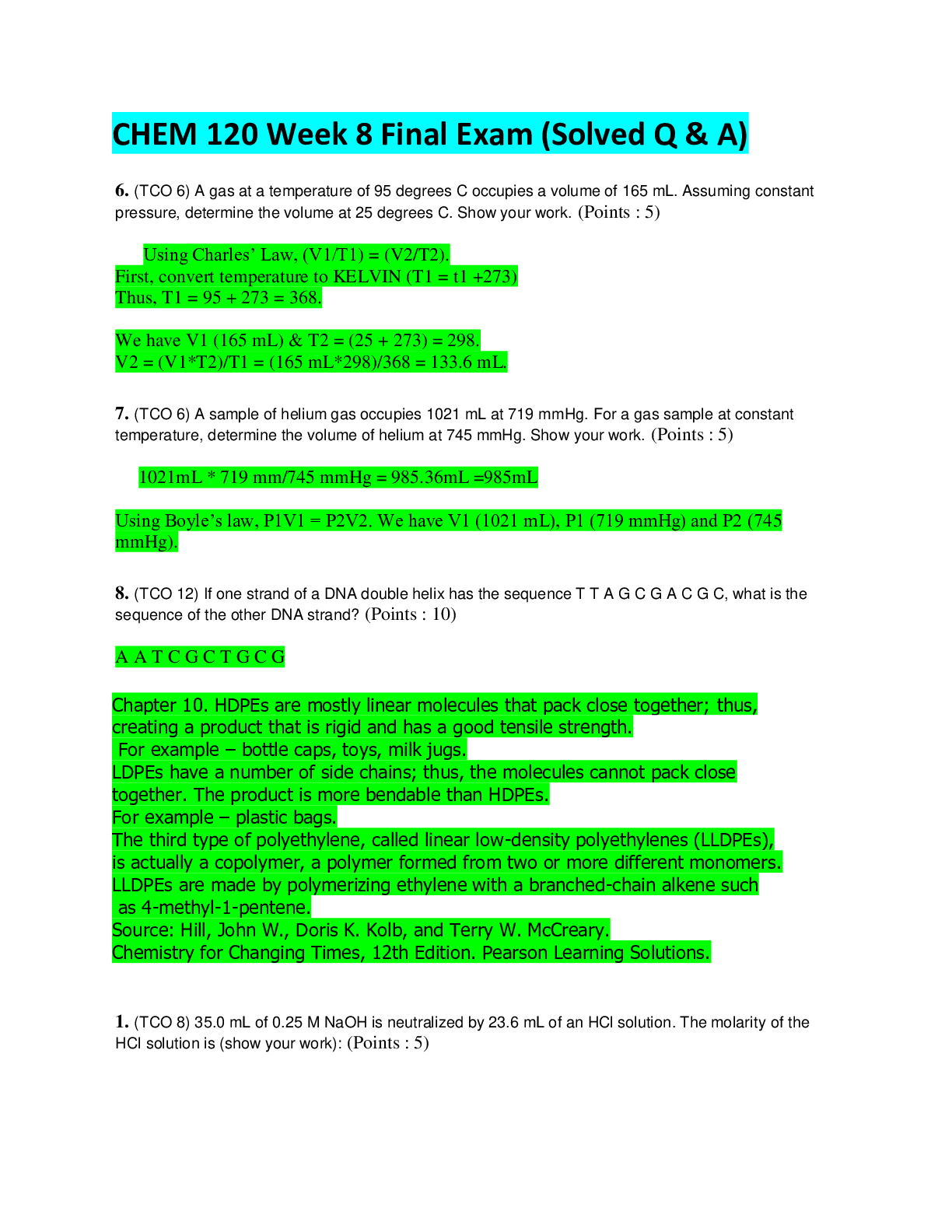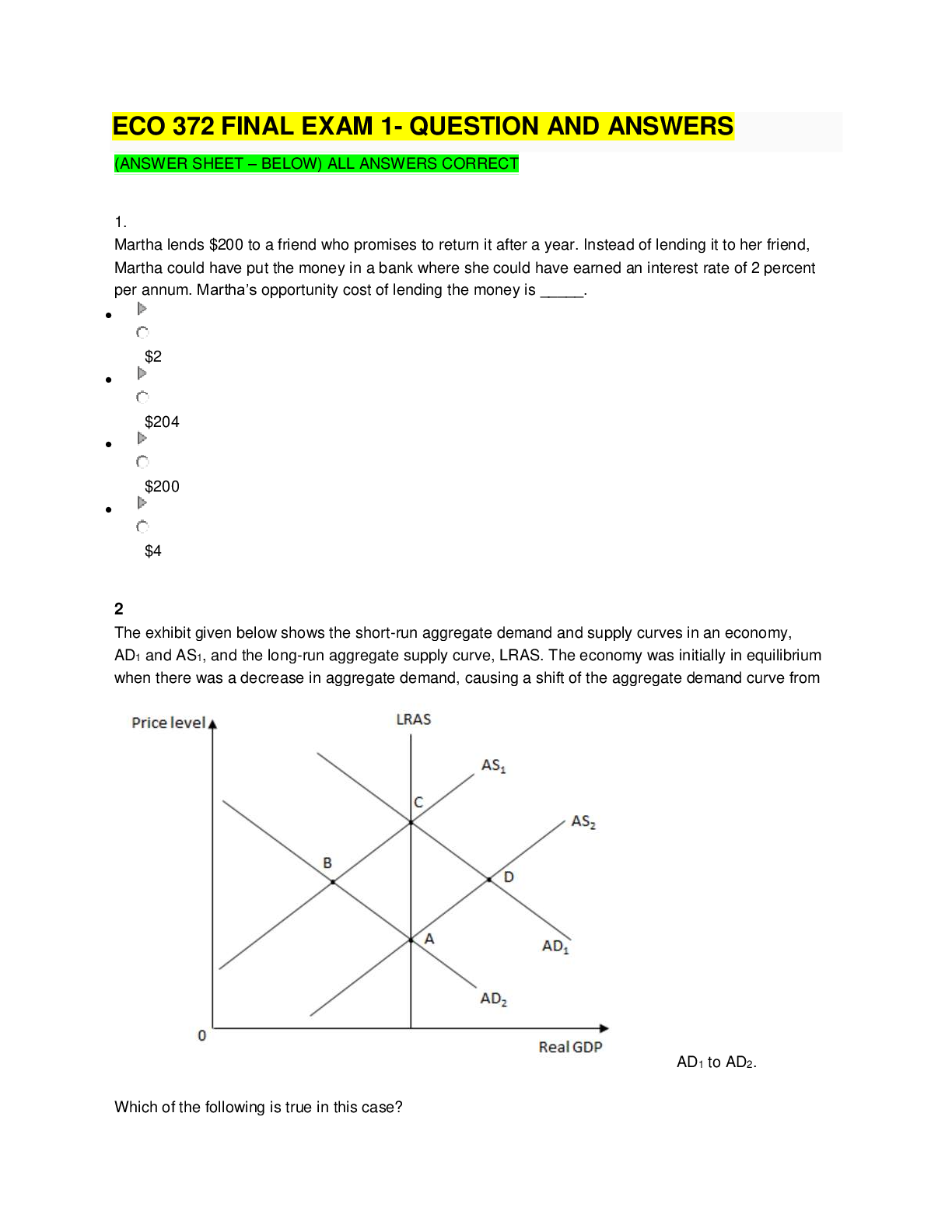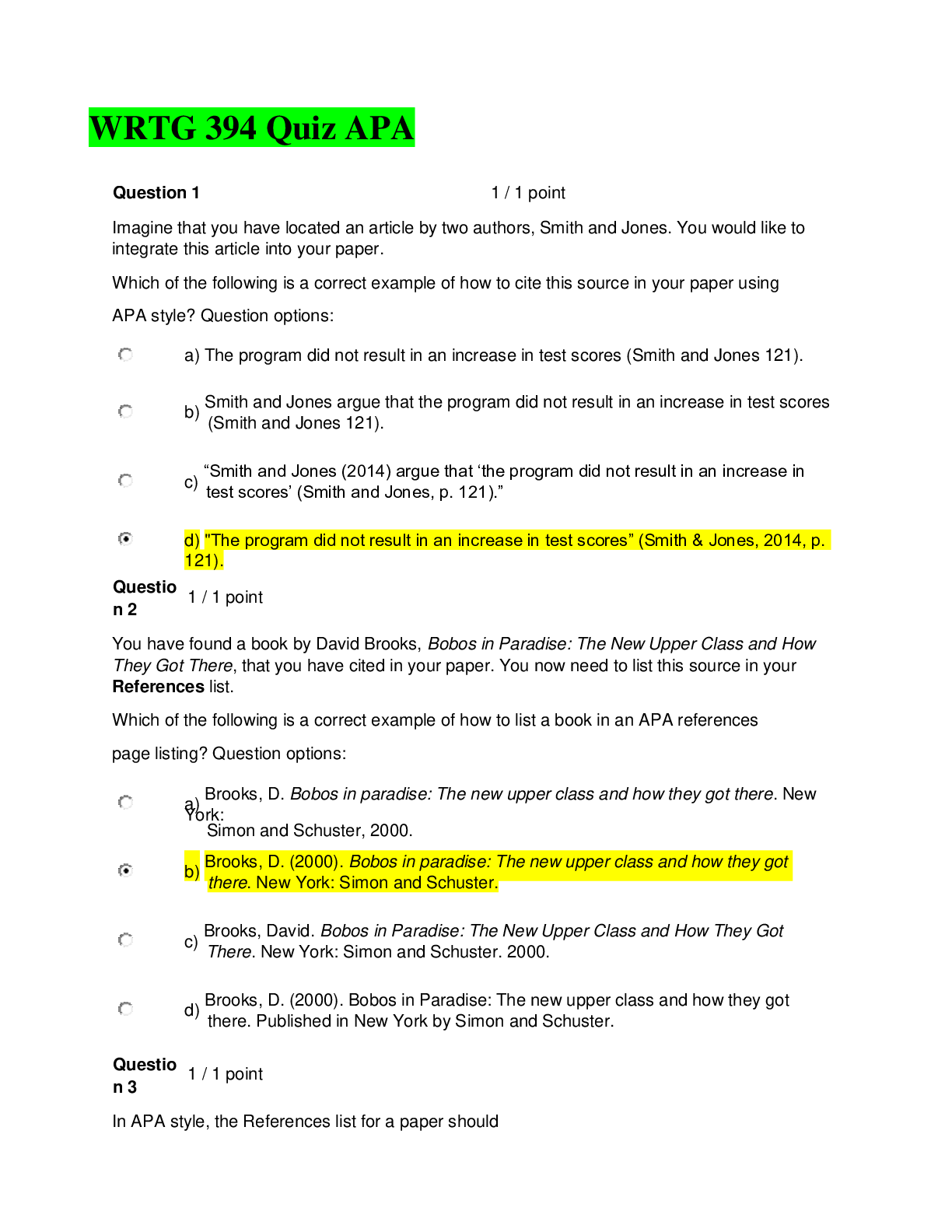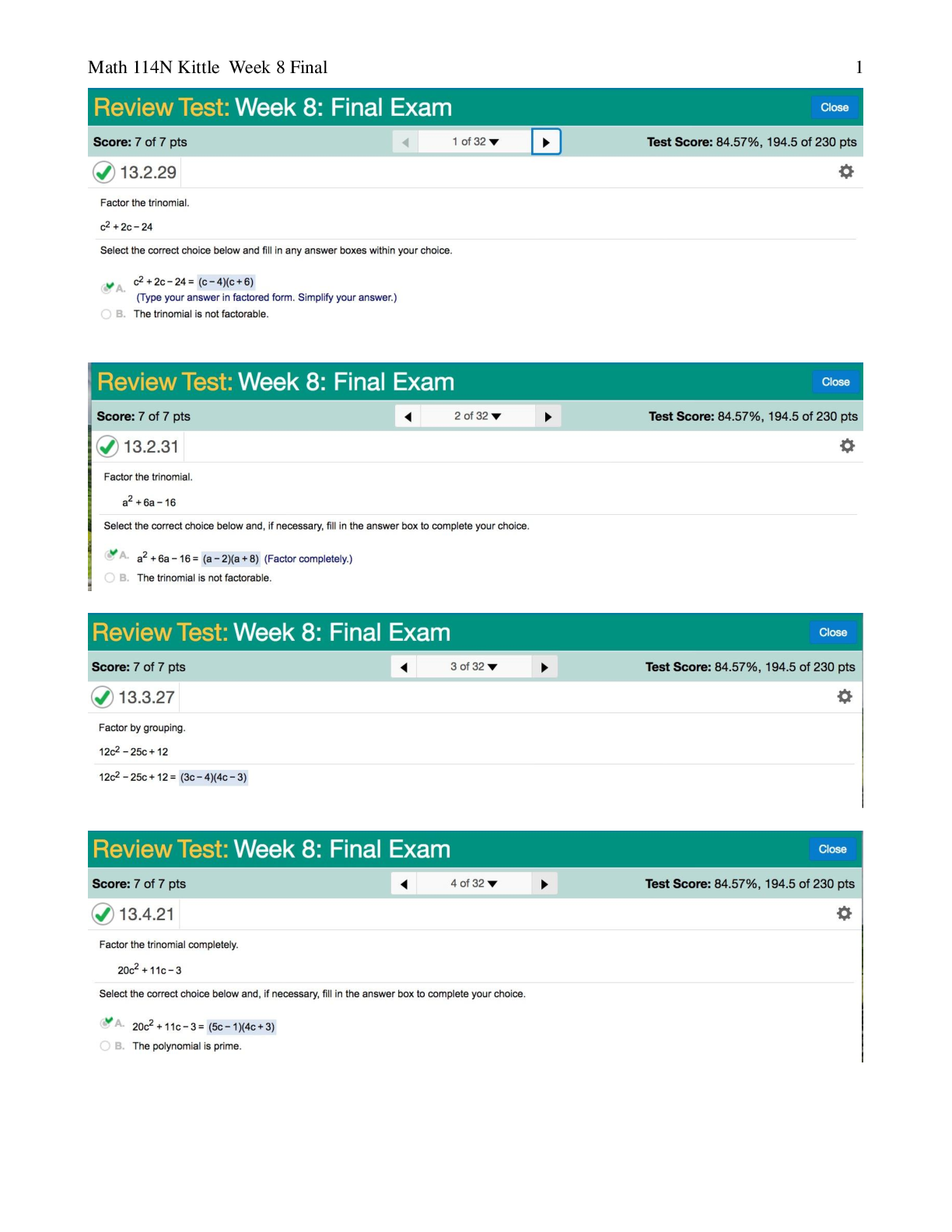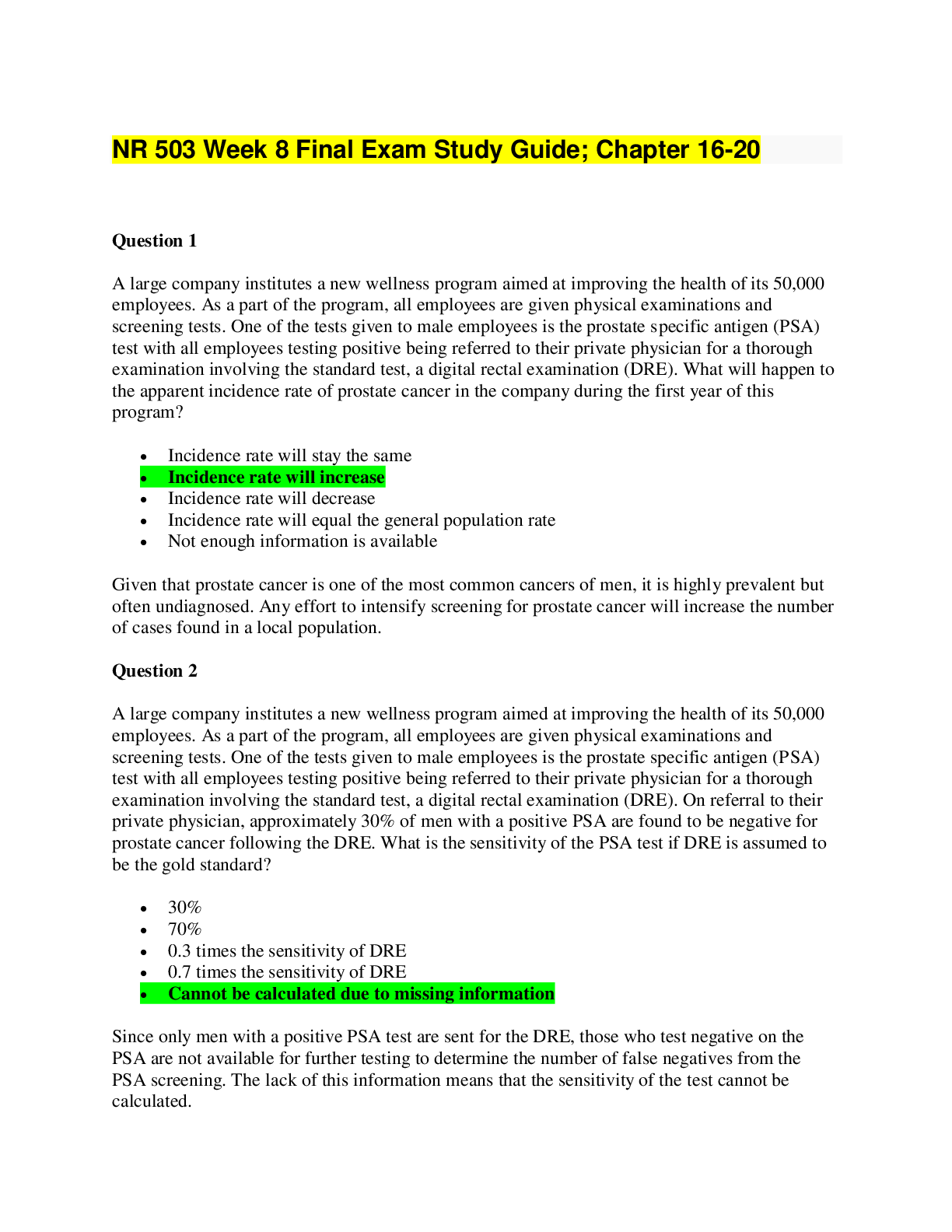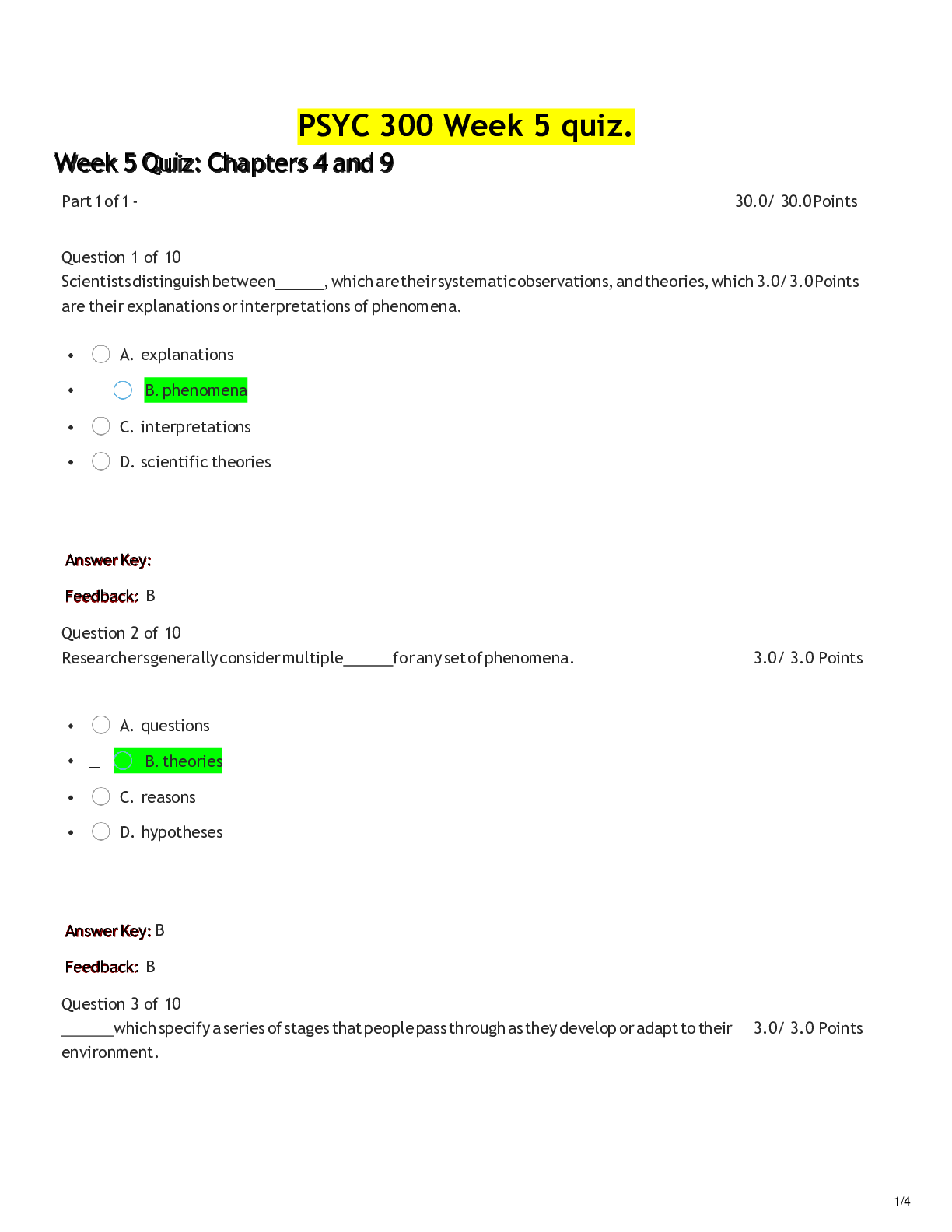Psychology > QUESTIONS & ANSWERS > PSYC 300 Week 8 Final Exam / PSYC 300 APUS Week 8 Final Exam - Latest 2019/20 Complete Answers, Atte (All)
PSYC 300 Week 8 Final Exam / PSYC 300 APUS Week 8 Final Exam - Latest 2019/20 Complete Answers, Attempt Score:180 Out of 180 points.
Document Content and Description Below
PSYC 300 Week 8 Final Exam. Question 1 of 24 Polly Petunia is Chief Horticulturalist for the Southwest region, encompassing Arizona, New Mexico, and Texas. She wants to survey amateur garden... ers in her region to determine what, if any, water conservation practices they employ in their home gardening. Polly sends her survey to 150 randomly selected gardeners in each state. Polly is using: A. purposive sampling. B. proportional stratified sampling. C. systematic sampling. D. stratified random sampling. Question 2 of 24 Danny Drive wants to know the relationship between intrinsic motivation and course grade among math students. He contacts a local professor who teaches several general education math classes and asks about the possibility of gathering data in her classes. Danny is using: A. simple random sampling. B. cluster sampling. C. convenience sampling. D. systematic sampling. Question 3 of 24 Statistical hypothesis testing involves testing the: A. research hypothesis B. probability level C. significant level D. null hypothesis Question 4 of 24 “There will be differences in degree of mood elevation seen in depressed clients after receiving either cognitive-behavioral or psychoanalytic therapy.” A. dependent variable. B. independent variable. C. confounding variable. D. constant. Question 5 of 24 “There will be differences in degree of mood elevation seen in depressed clients after receiving either cognitive-behavioral or psychoanalytic therapy.” During a test of this hypothesis, it was discovered that some of the participants lived with family members and others lived alone. This variable, living situation, is a/an . A. independent variable. B. dependent variable. C. constant. D. confounding variable. Question 6 of 24 Dr. Dow Jones wants to know whether a problem-based approach to teaching economics will result in higher academic performance than his traditional method. Of the six sections of Economics 101 at his university, Dr. Jones randomly assigns three sections to the traditional method and three sections to the problem-based method. At the end of the semester, all students complete the same final exam. In this design, students studying under the traditional method constitute the: A. placebo group. B. treatment group. C. sample. D. control group. Question 7 of 24 Dr. Dow Jones wants to know whether a problem-based approach to teaching economics will result in higher academic performance than his traditional method. Of the six sections of Economics 101 at his university, Dr. Jones randomly assigns three sections to the traditional method and three sections to the problem-based method for Unit 1 of the course. Then all sections switch instructional method for Unit 2. He plans to compare the performance of the two groups of sections on their Unit 1 and Unit 2 exams. This study employs a design. A. within subjects (repeated measures) B. quasi-experimental C. true experimental D. ex post facto Question 8 of 24 Penny Poodle wanted to know which dog obedience training program was more effective: Puppy Pride, the approach she has been using for any years, or Doggie Do-Right, a new approach. Penny convinced 50 human companions of untrained dogs to participate in her study. The dogs and their humans were randomly assigned to complete the Puppy Pride or Doggie Do-Right course. At the end of the training programs, all of the dogs were scored on their level of obedience on a standardized dog obedience checklist (scores could range from 10 to 100). In this study, is the independent variable. A. Doggie Do-Right B. type of dog training program C. score on the dog obedient checklist D. obedience training versus no training Question 9 of 24 Dr. Robbins wants to know if there are different opinions regarding the value of public school education between Native Americans who have at least one relative who attended Indian Boarding School and Native Americans who have no family experience with Indian Boarding School. Dr. Robbins contacts 35 Native American participants in each group. He wants each group to include younger as well as older adults, and a mix of male and female participants. He asks each person to complete a survey about their attitudes toward public education. In this study, is the dependent variable. A. score on the “attitude toward public schools” measure B. experience with Indian boarding school C. gender of participant D. age of participant Question 10 of 24 Mixed-methods research is characterized by the use of A. more than one qualitative method B. more than one quantitative method C. quantitative, qualitative, and action research method D. quantitative and qualitative methods Question 11 of 24 Which of the following is the major advantage of mixed-methods research? A. It provides unlimited opportunities to collect data B. It requires a researcher to possess both qualitative and quantitative research skills C. It incorporates the strengths of both quantitative and qualitative methods D. It prevents contradictions with traditional research Question 12 of 24 How are inferential statistics different from descriptive statistics? A. Descriptive statistics allow one to draw inferences from the sample to a target population. B. Descriptive statistics verify the accuracy of the inferential statistics. C. Inferential statistics describe the results of a study. D. Inferential statistics allow one to draw inferences from the sample to a target population. Question 13 of 24 are characteristics of samples, whereas are characteristics of populations. A. Concepts; statistics B. Parameters; statistics C. Statistics; parameters D. Parameters; estimations Question 14 of 24 The mean of this set of scores 5, 3, 7, 3, 6, 2, 5, 3 is . A. 3 B. 4 C. 4.25 D. 4.5 Question 15 of 24 The median of this set of scores 5, 3, 7, 3, 6, 2, 5, 3 is . A. 2 B. 3 C. 4 D. 4.5 Question 16 of 24 The mode of this set of scores 5, 3, 7, 3, 6, 2, 5, 3 is . A. 3 B. 4 C. 4.22 D. 4.5 Question 17 of 24 The z-score, or standard score, allows the research to determine: A. how far a target individual’s score is from the group mean. B. what percentage of individuals in the sample scored above the target individual. C. the mean for the population based on the mean for the sample. D. what percentage of individuals in the sample scored below the target individual. Question 18 of 24 The percentile rank allows the researcher to determine: A. how far a target individual’s score is from the group mean. B. what percentage of individuals in the sample scored above the target individual. C. the mean for the population based on the mean for the sample. D. what percentage of individuals in the sample scored below the target individual. Question 19 of 24 An exam was given to two sections of the same course. In Section 1, the exam mean was 51 and the standard deviation was 7. In Section 2, the exam mean was 51 and the standard deviation was 13. Which of the following conclusions is accurate? A. Section 1 did better on the exam than Section 2. B. Section 1 scores were more variable than Section 2. C. Section 1 scores were less variable than Section 2. D. Section 1 did less well on the exam than Section 2. Question 20 of 24 Danzell is a purchasing agent for a major grocery store chain. He has noticed over the years that the higher the outdoor temperature, the more likely people are to buy fresh fruit. Based on Danzell’s observations, we would say there is relationship between outdoor temperature and buying of fresh fruit. A. a positive B. a negative C. a causal D. no Question 21 of 24 How can a “researcher acting as an instrument” in a qualitative study best ensure the trustworthiness of the data analysis and the conclusions? Question 22 of 24 The study of how ideas developed over time is a type of conceptual or psychological historical research. Identify a key concept in your own discipline and describe in detail the types of primary sources you could use to understand its history, explaining what each source might add to the study. Question 23 of 24 A medical researcher is concerned about mistakenly concluding that a new medication is effective when it really is not. What type of error is the researcher concerned about making (Type I or Type II)? Describe what the researcher might do to decrease the likelihood of making that type of error. Discuss ramifications of your suggested approach for other types of error in the study. Question 24 of 24 Throughout your textbook the authors return to the importance of interpreting the findings of a research project. Explain why this is an essential element in a high-quality research report. [Show More]
Last updated: 1 year ago
Preview 1 out of 16 pages
Instant download
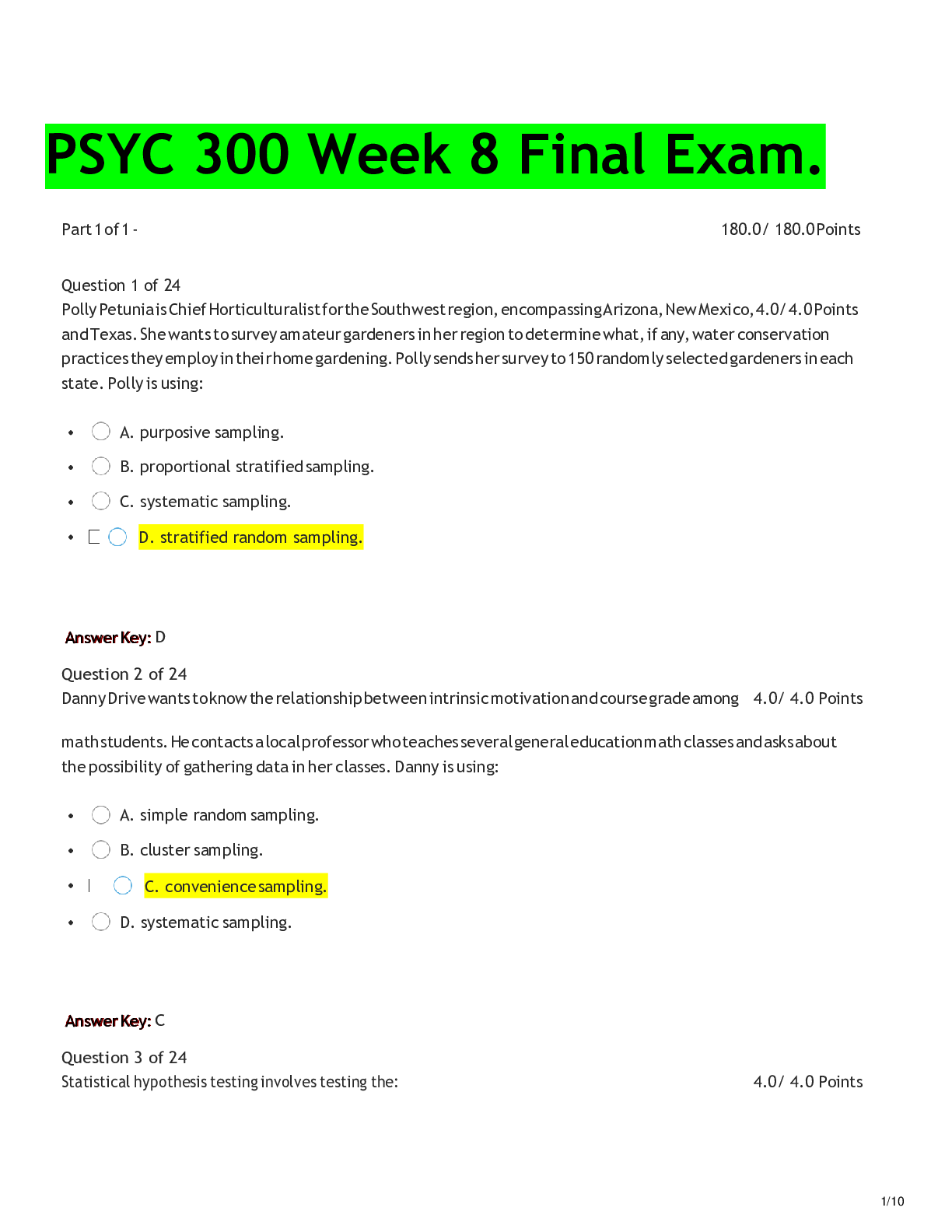
Buy this document to get the full access instantly
Instant Download Access after purchase
Add to cartInstant download
Reviews( 0 )
Document information
Connected school, study & course
About the document
Uploaded On
Apr 06, 2020
Number of pages
16
Written in
Additional information
This document has been written for:
Uploaded
Apr 06, 2020
Downloads
1
Views
70

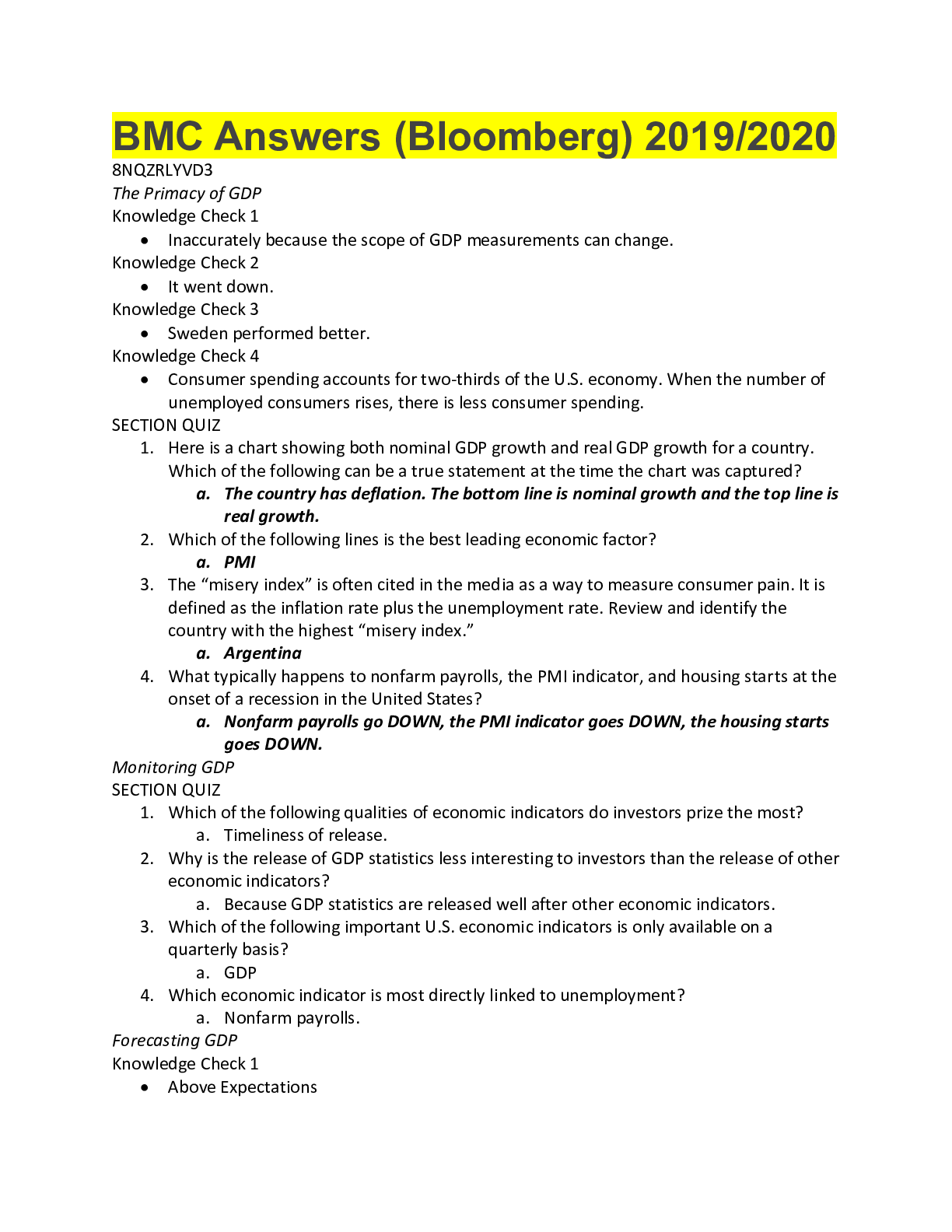
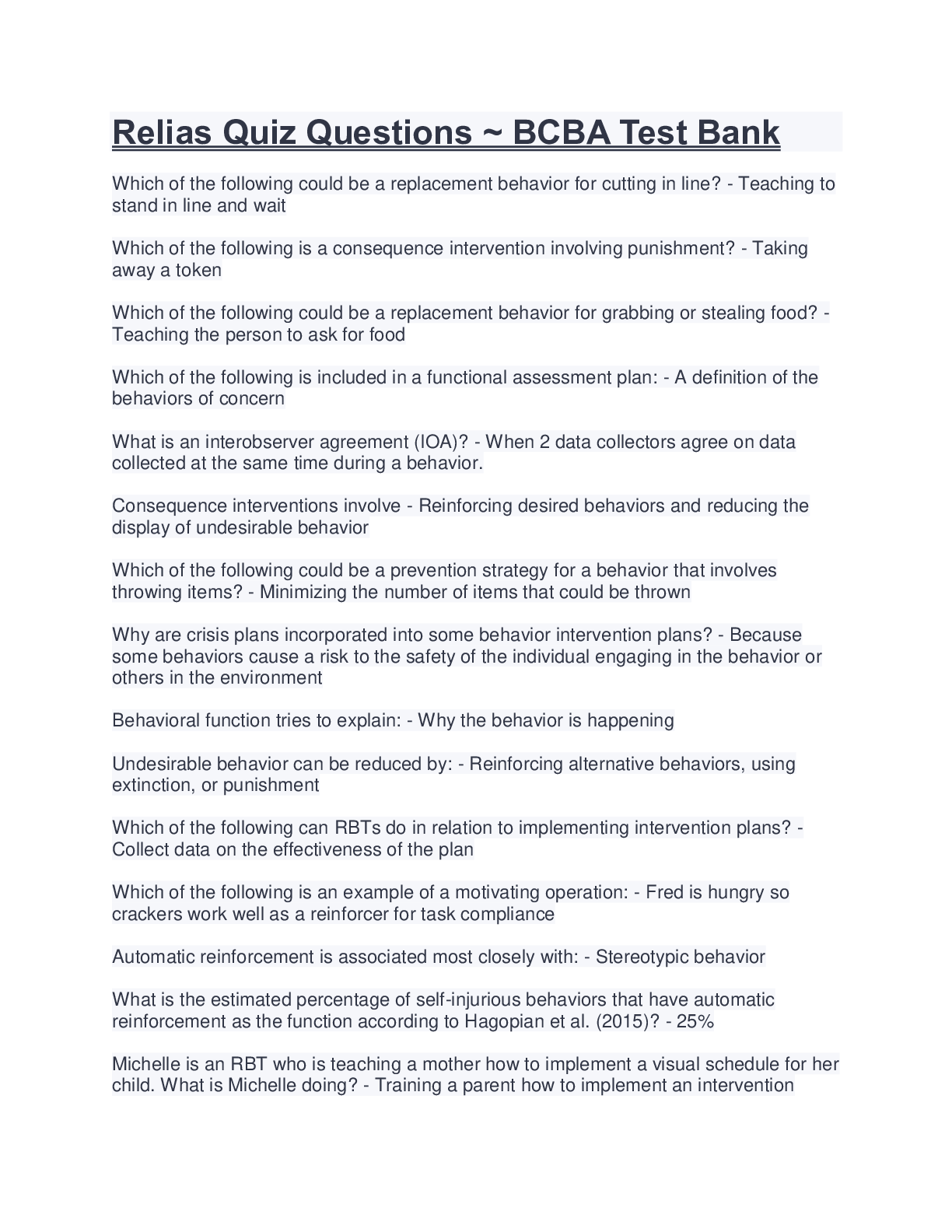
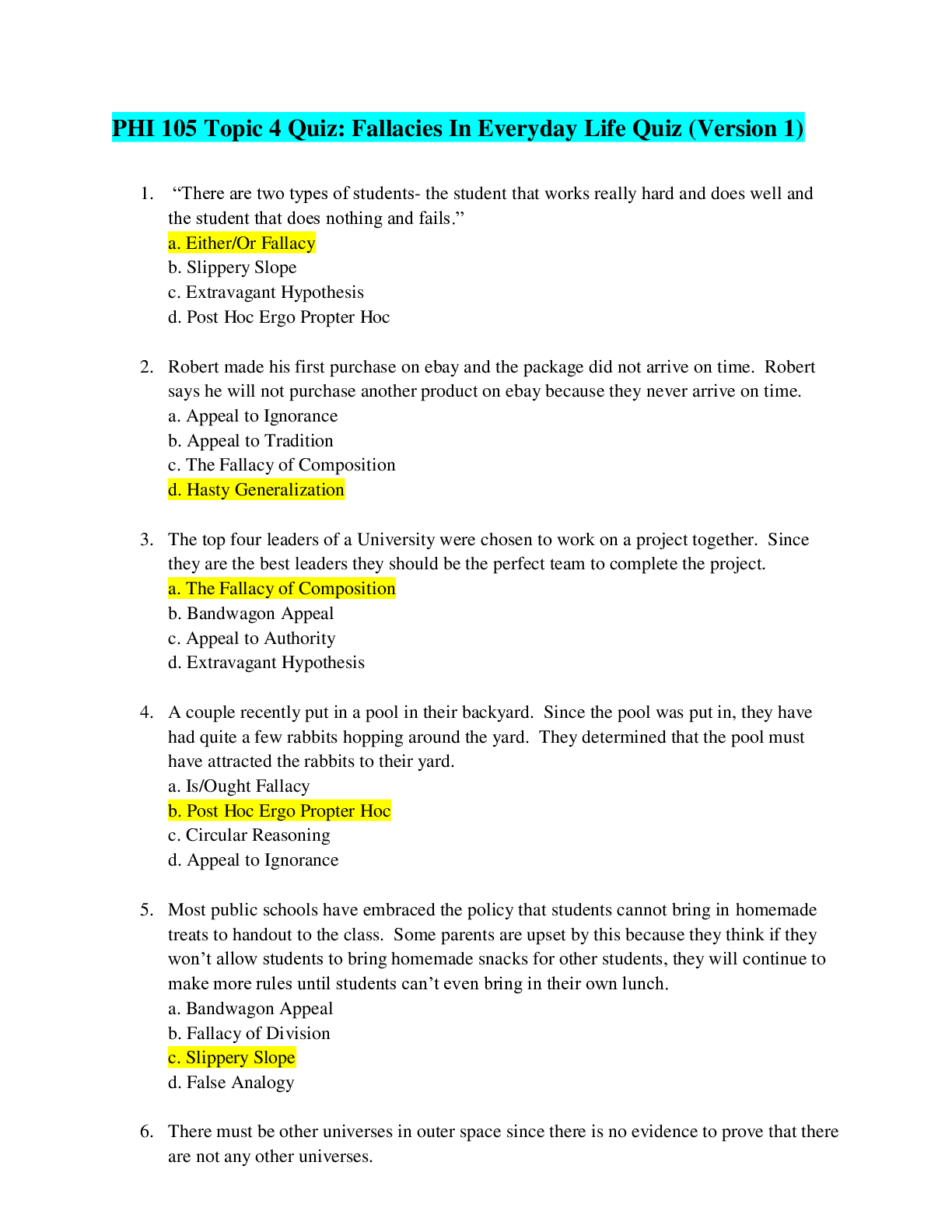

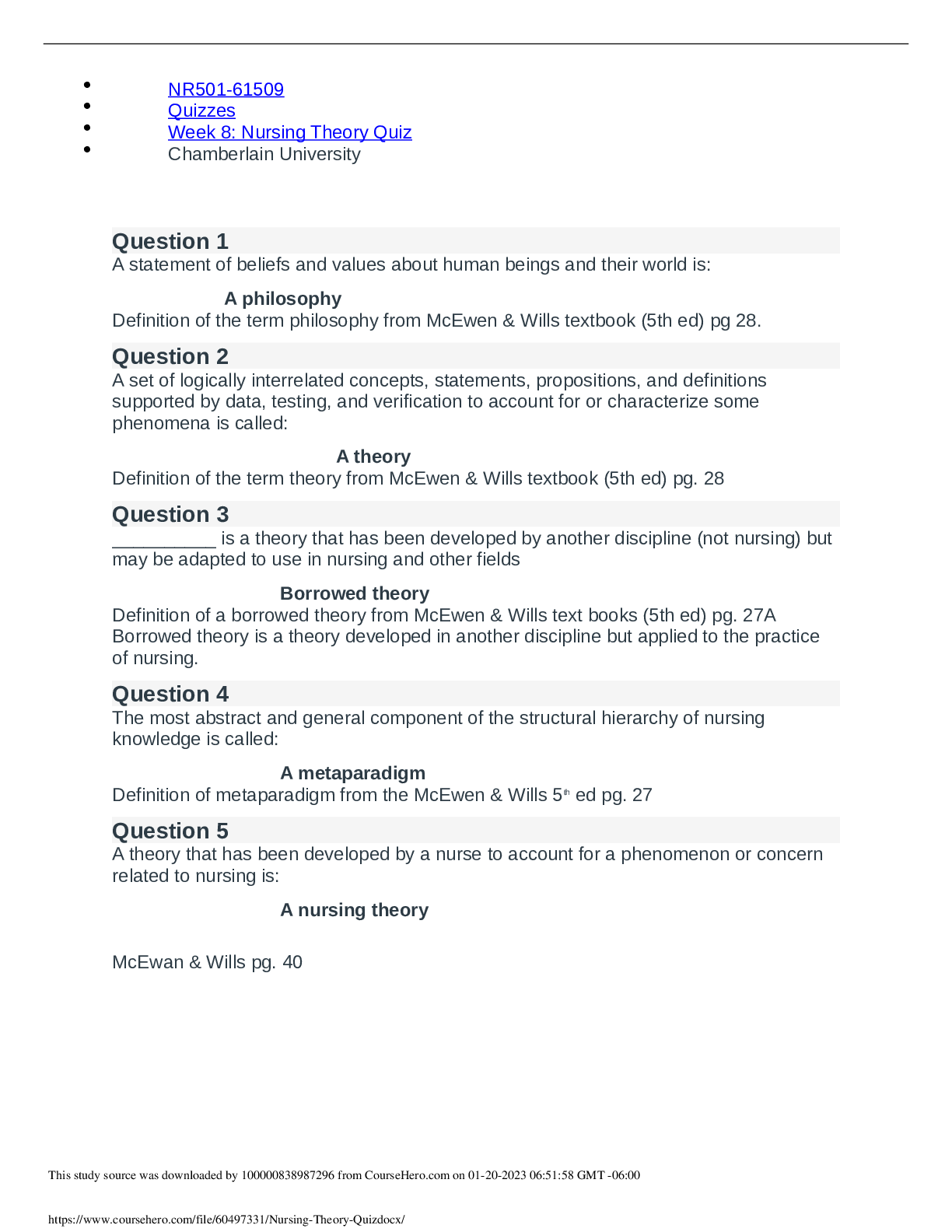
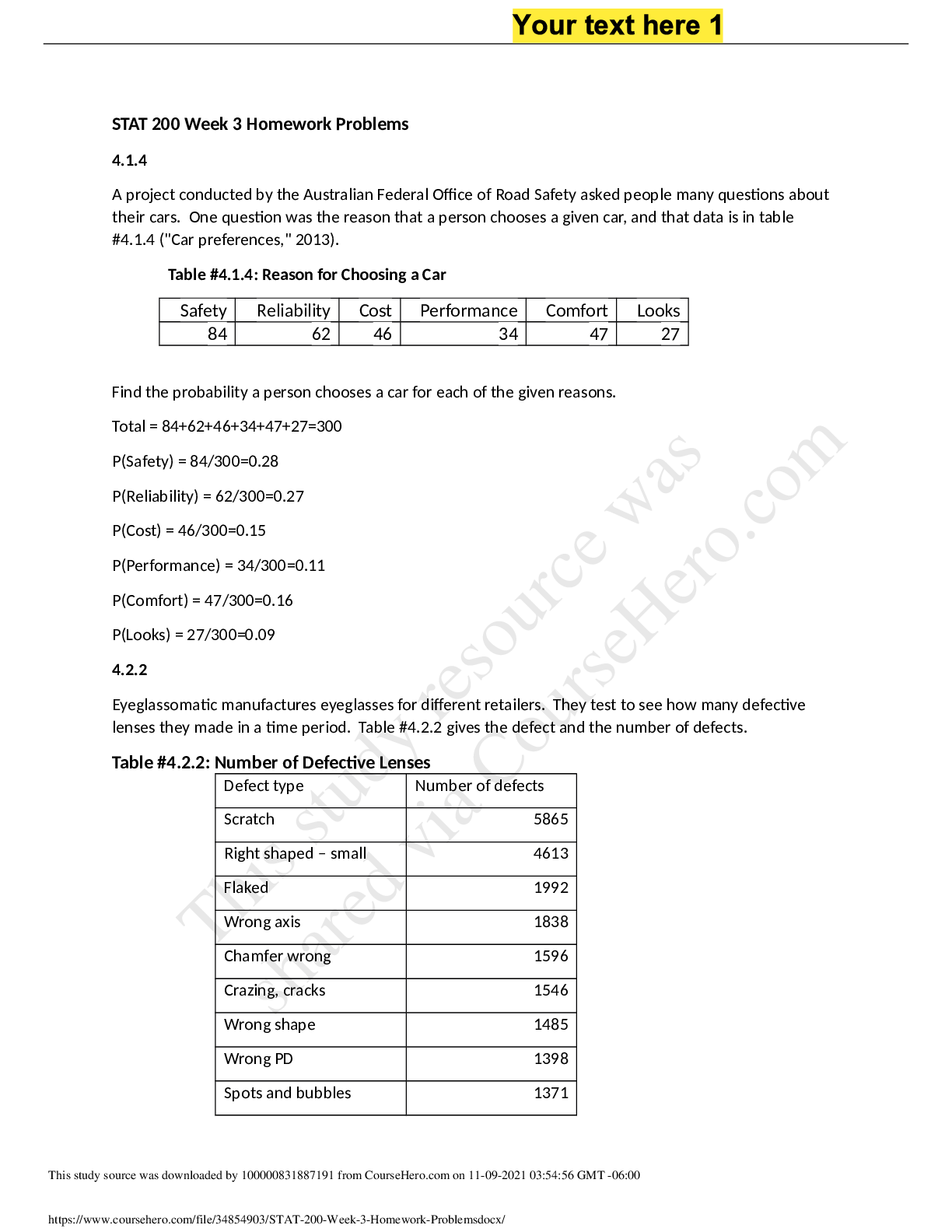
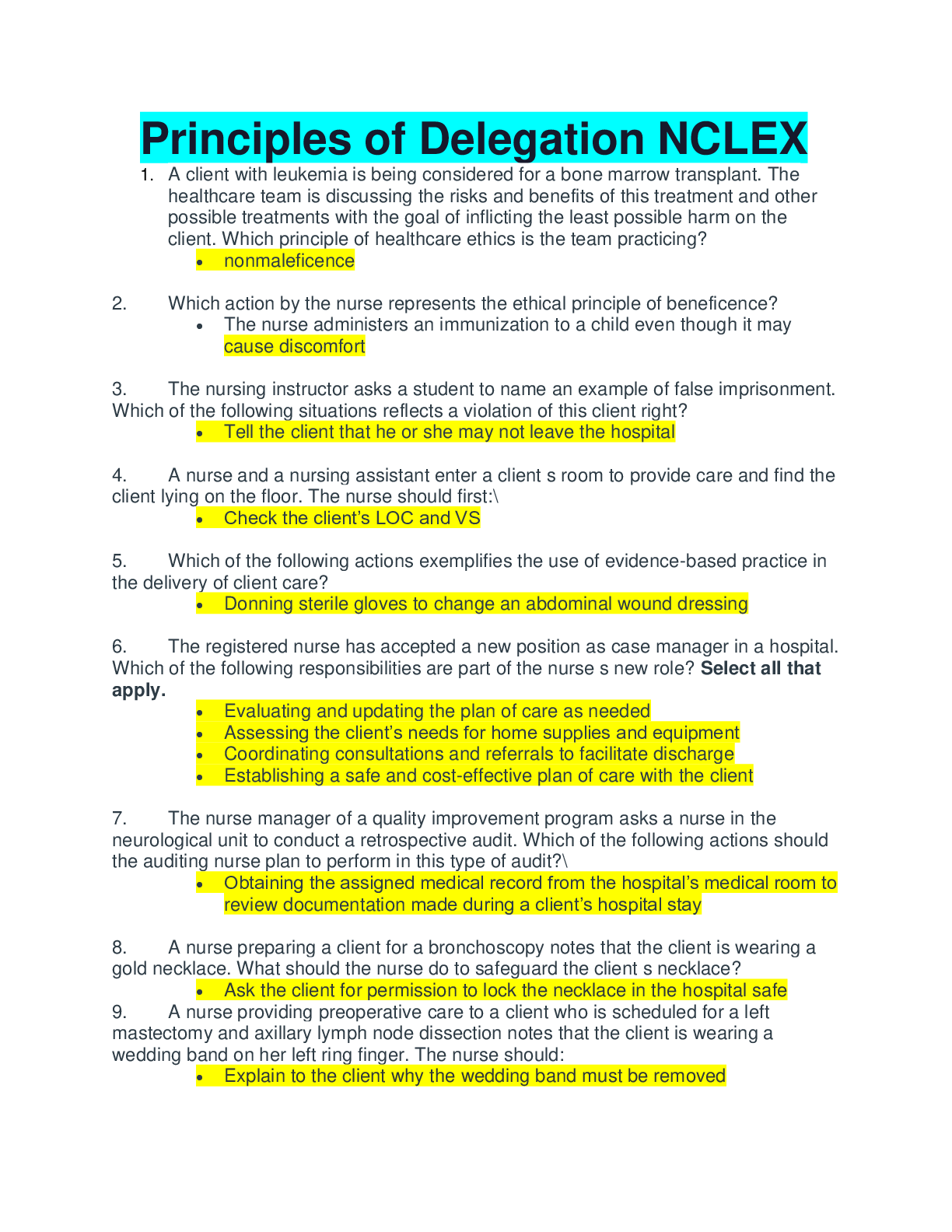
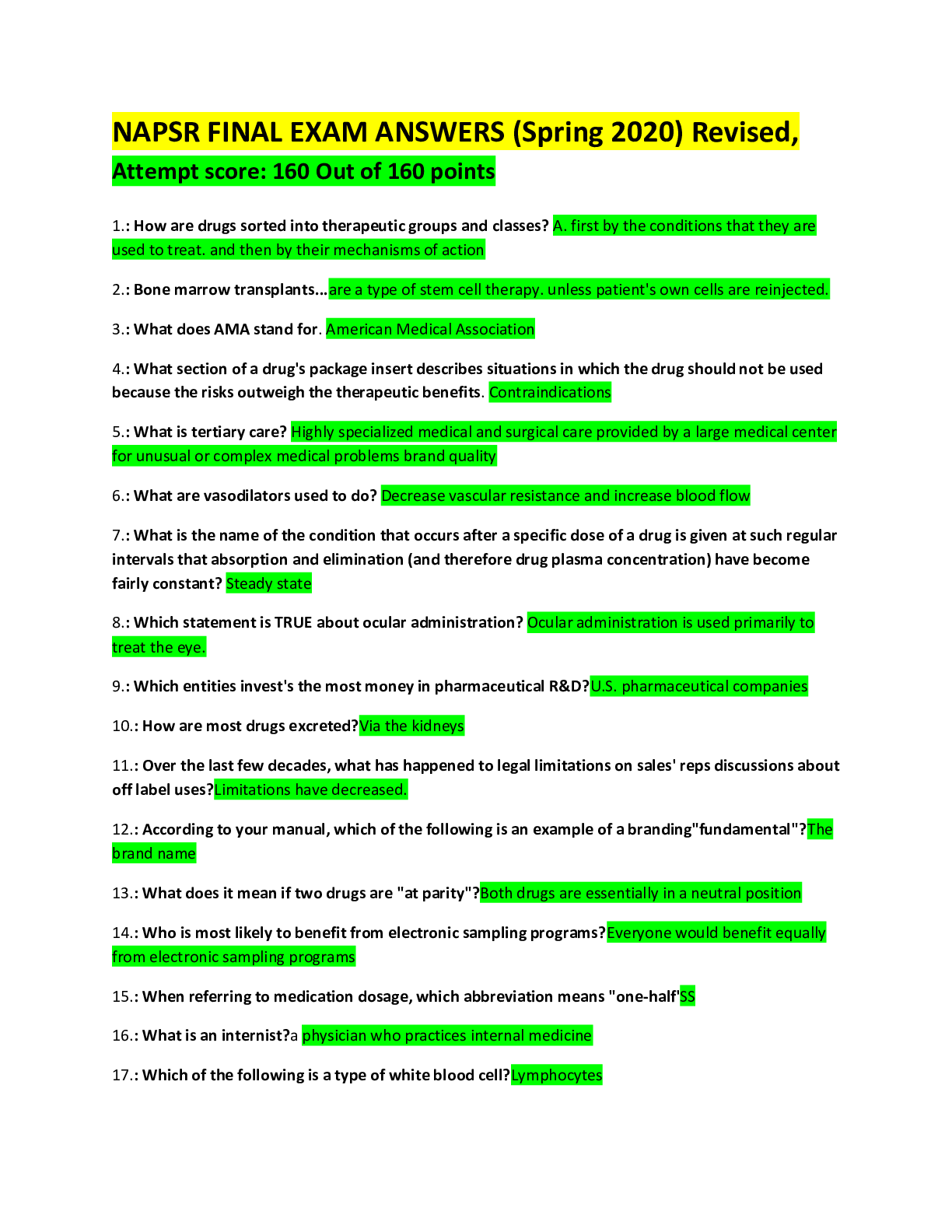
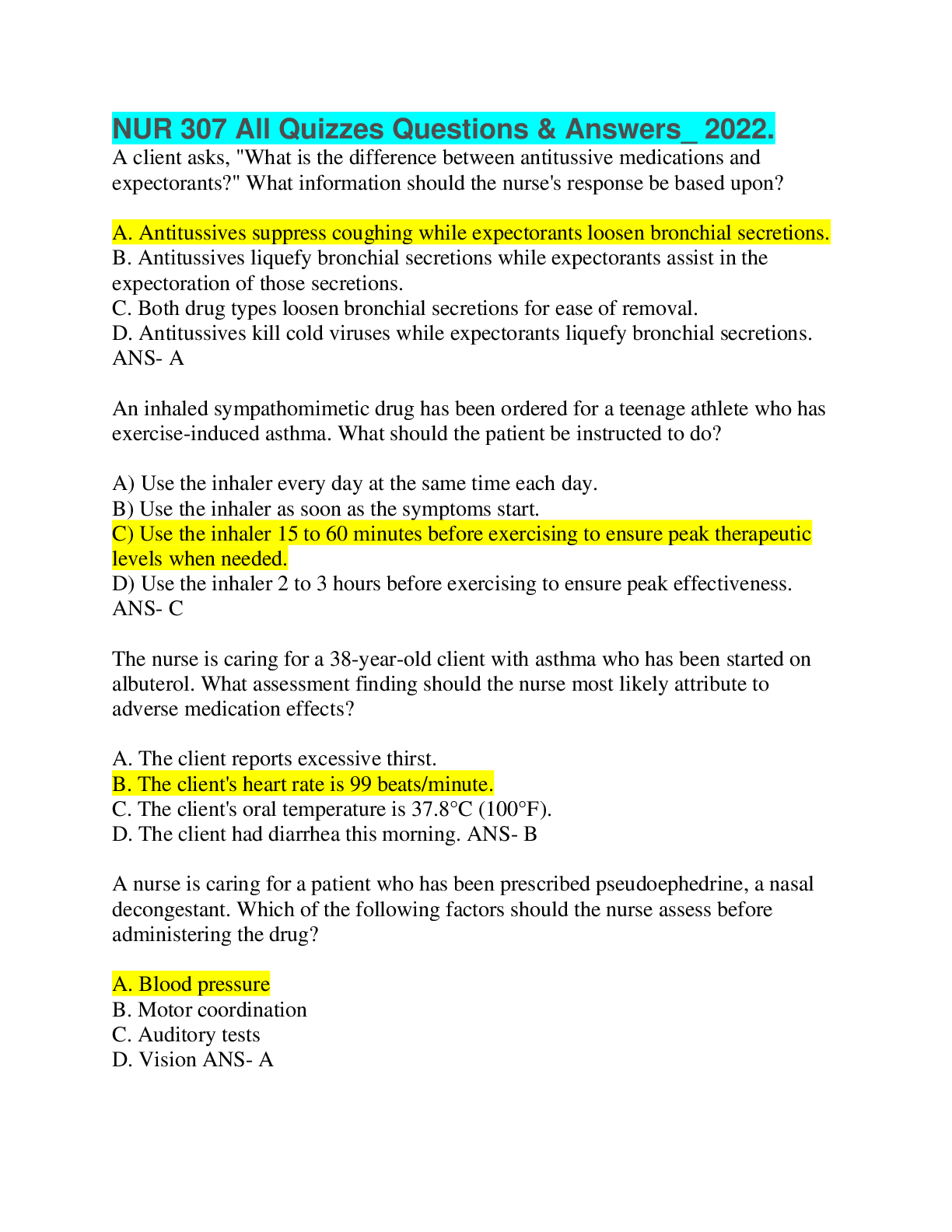
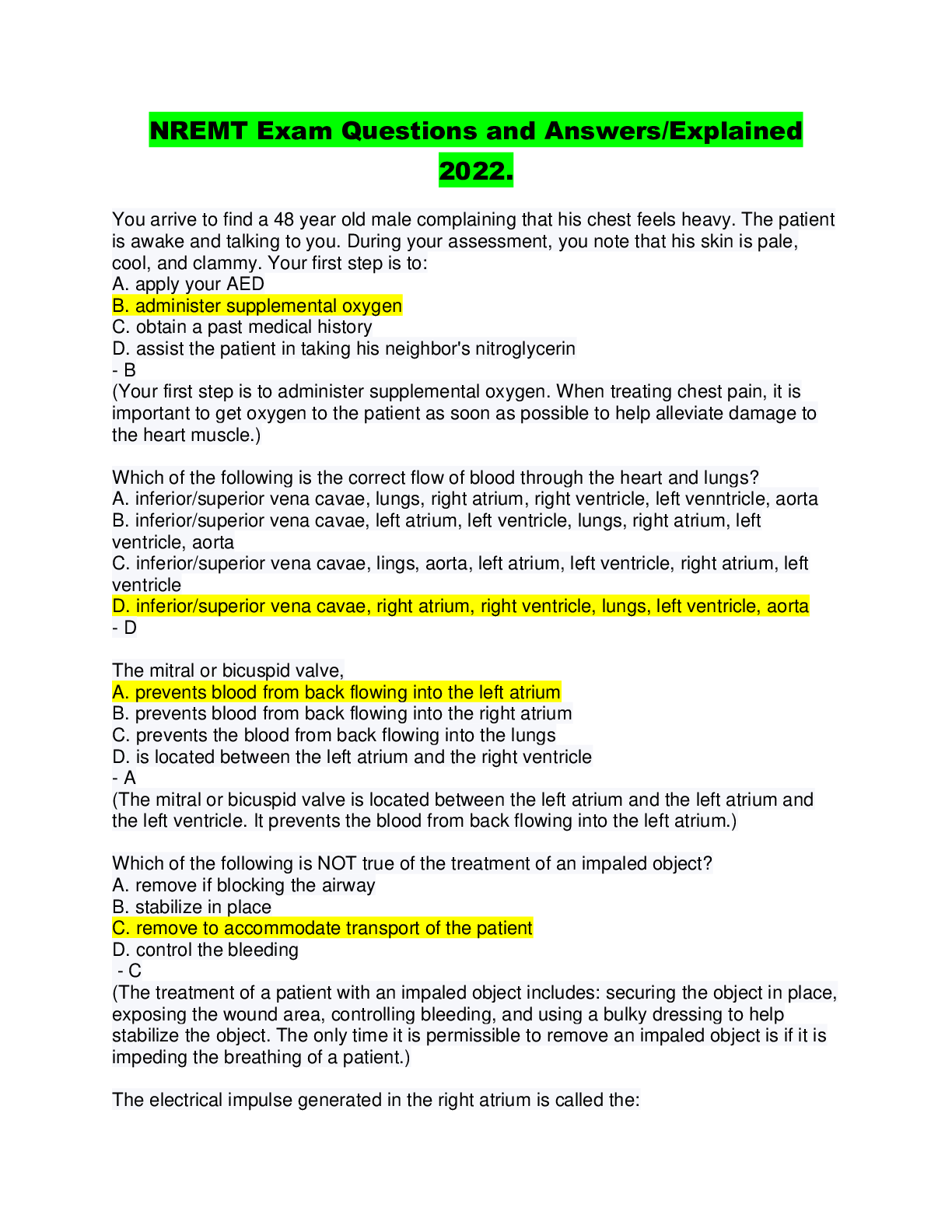
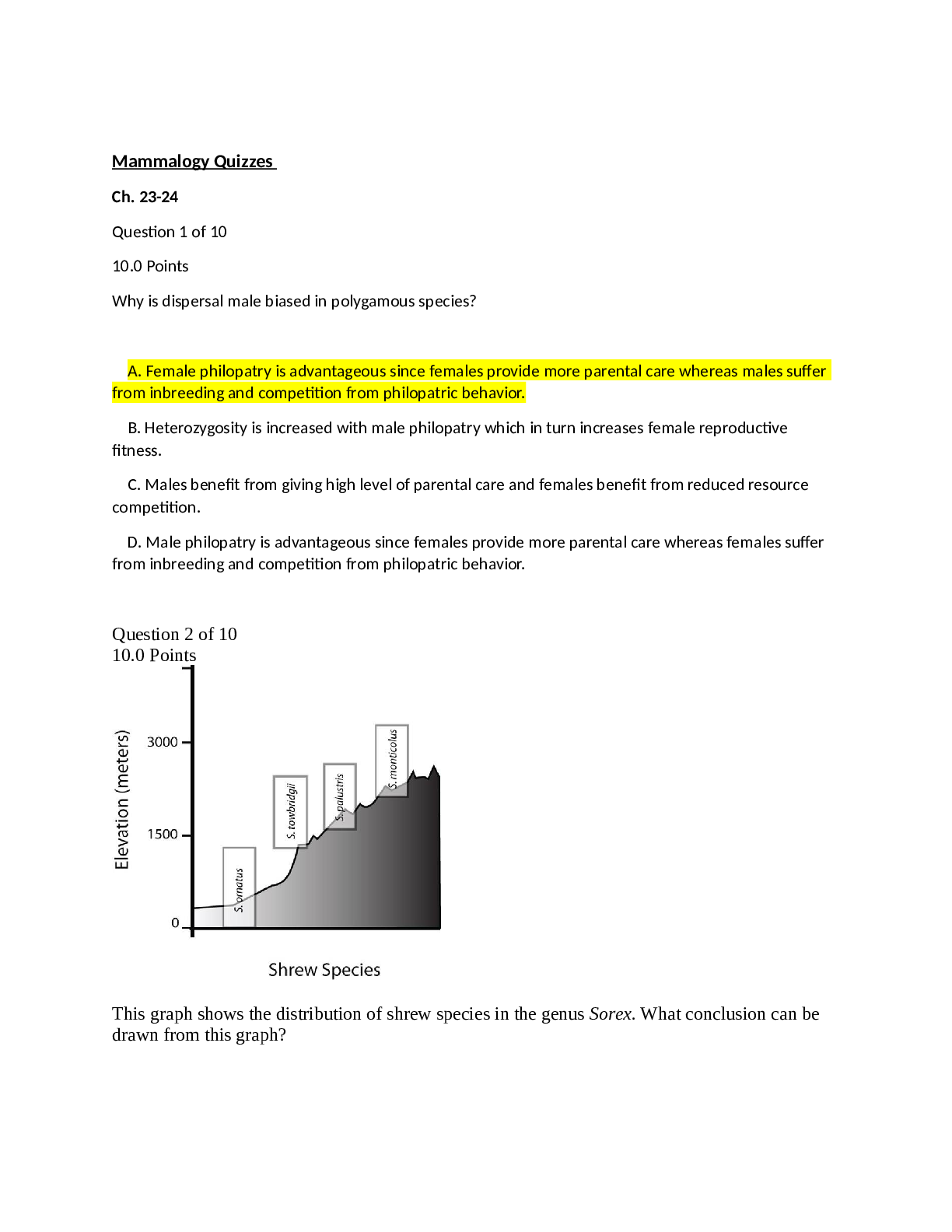
.png)
